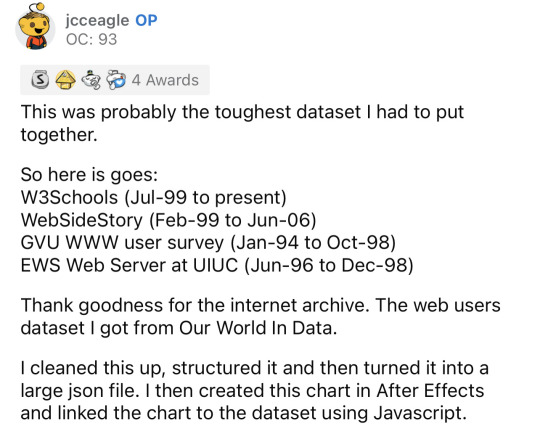#google mobile
Text
3 notes
·
View notes
Text
Google Pixel 7a
#mobile#google mobile#mobile phone#google pixel#google smartphone#google#google pixel 7a#smartphone#pixel 7a
1 note
·
View note
Text

Reddit • YouTube
#data#top post#statistics#web browsers#chrome#google chrome#educational#Firefox#opera#mozilla#mozilla firefox#internet explorer#internet#statistical data#video#Netscape#data is beautiful#I still use Firefox and probably will forever unless it closes down#switch from your default browser to Firefox and use DuckDuckGo’s search engine#this goes for mobile users too.
105K notes
·
View notes
Text

꧁★꧂
#sidekick#cell phones#slide phone#t mobile#google#keychain#heart#pink#old tech#nostalgia#nostalgiacore#webcore#flickr#oldweb#old web#2008
2K notes
·
View notes
Text
Tesvery India Private Limited - coming Soon...
#frank iero#hunter wittebane#laena velaryon#aemond targaryen#youtube#google#google mobile#george sear#sareestyle#brand petticoat#tesvery petticoat#tesveryindiaprivatelimited#nagpur petticoat#distributor#petticoat distributor#cheapest petticoat#womens wear#nagpur petticoat manufacturer#khaperkheda petticoat#petticoat supplier's#viralpost
0 notes
Text
I was reminded by a reply that I should probably emphasize this: the Big Cat Public Safety Act literally has an exemption specifically for state colleges and universities. Why? Because there’s two schools with live mascots who live in habitats on campus, and their representatives absolutely would not have supported the bill if it had taken away their college’s cats.
Meet Mike VII at Louisiana State University:

And Leo III at the University of North Alabama:

(Leo III’s mate, Una, passed away a few years ago).
It’s tradition for these schools to have a live mascot, so the bill that *checks notes* is meant to end unethical commercial of big cats had to ensure that they’d still be allowed to have a big cat living next to their stadiums. Luckily neither school takes their mascots to the sidelines of football games anymore, but LSU actually only just stopped that practice in 2017.
These mascot cats have consistently been part of the commercial trade in big cats, although it’s unclear if they will continue to be (even though it’s still legal for these schools to buy their next mascot). Una and Leo III came from a wildlife park in New Hampshire as young cubs, and Mike VII is ostensibly a rescue but the story of the facility he came from doesn’t quite pass the smell test.
Here’s the wild thing. Under the new law, right, most entities that want to keep big cats - like sanctuaries and zoos - have to follow certain rules regarding fencing and breeding restrictions and preventing public contact in order to be allowed to do so. But state schools? Nada. They can buy, sell, and breed without any limits. They could, quite literally, run a tiger puppy-mill or start a cub petting franchise across multiple state universities and it wouldn’t be illegal. Obviously that’s a worst case scenario that’s super unlikely, but it goes to show just how odd it is that these entities have a totally unrestricted exemption. Credible zoological facilities and sanctuaries have to comply with much stricter regulations to prove they’re not exploiting the cats in their care, but for the sake of football, state colleges and universities can do whatever they want!! (sigh). It’s amazing how really specific political interests, such as the culture around football mascots, can result in carve-outs in even bills promoted specifically to create consistent regulations for animal welfare.
#big cat public safety act#college mascots#big cats#Mike the tiger#Mike vii#Leo the Lion#Leo iii#the mobile app isn’t letting me embed links but you can double check all the details about these cats on their websites#just Google their names and it’s easy to find
3K notes
·
View notes
Text
Mobility aid TF2? Well I'll give you one better...


GAY MOBILITY AID TF2
I BETCHA DIDN'T SEE THAT ONE COMING
THEY'RE GAY NOW
EDIT: Hey so I just realized I drew Medic in a hospital wheelchair for some reason? Instead of a manual one?? Maybe it's because in my reference pic it was a hospital wheelchair, but I swear I remember thinking about changing it to a manual one? I guess I was just being a dumbass and forgot lmao, sorry y'all
#I DONT ACTUALLY KNOW IF WHEELCHAIRS CAN SUPPORT TWO PEOPLE AT ONCE#GOOGLE HELPED ME NONE- SO LET'S JUST IMAGINE THAT MISS PAULING'S WHEELCHAIR IS ONE STRONG MOTFUCKER#tf2#team fortress two#my art#tf2 medic#tf2 engineer#tf2 science party#science party#tf2 pyro#tf2 miss pauling#tf2 miss fire#mobility aid#disability#wheelchair user#prosthetics#partial nudity#ALSO I DID SEE ALL UR ASKS ABOUT MORE MOBILITY AID TF2 HEADCANONS I AM JUST VERY BURNT OUT ATM#SORRY :(#disabilitymercs
629 notes
·
View notes
Text
Subprime gadgets

I'm on tour with my new, nationally bestselling novel The Bezzle! Catch me THIS SUNDAY in ANAHEIM at WONDERCON: YA Fantasy, Room 207, 10 a.m.; Signing, 11 a.m.; Teaching Writing, 2 p.m., Room 213CD.

The promise of feudal security: "Surrender control over your digital life so that we, the wise, giant corporation, can ensure that you aren't tricked into catastrophic blunders that expose you to harm":
https://locusmag.com/2021/01/cory-doctorow-neofeudalism-and-the-digital-manor/
The tech giant is a feudal warlord whose platform is a fortress; move into the fortress and the warlord will defend you against the bandits roaming the lawless land beyond its walls.
That's the promise, here's the failure: What happens when the warlord decides to attack you? If a tech giant decides to do something that harms you, the fortress becomes a prison and the thick walls keep you in.
Apple does this all the time: "click this box and we will use our control over our platform to stop Facebook from spying on you" (Ios as fortress). "No matter what box you click, we will spy on you and because we control which apps you can install, we can stop you from blocking our spying" (Ios as prison):
https://pluralistic.net/2022/11/14/luxury-surveillance/#liar-liar
But it's not just Apple – any corporation that arrogates to itself the right to override your own choices about your technology will eventually yield to temptation, using that veto to help itself at your expense:
https://pluralistic.net/2023/07/28/microincentives-and-enshittification/
Once the corporation puts the gun on the mantelpiece in Act One, they're begging their KPI-obsessed managers to take it down and shoot you in the head with it in anticipation of of their annual Act Three performance review:
https://pluralistic.net/2023/12/08/playstationed/#tyler-james-hill
One particularly pernicious form of control is "trusted computing" and its handmaiden, "remote attestation." Broadly, this is when a device is designed to gather information about how it is configured and to send verifiable testaments about that configuration to third parties, even if you want to lie to those people:
https://www.eff.org/deeplinks/2023/08/your-computer-should-say-what-you-tell-it-say-1
New HP printers are designed to continuously monitor how you use them – and data-mine the documents you print for marketing data. You have to hand over a credit-card in order to use them, and HP reserves the right to fine you if your printer is unreachable, which would frustrate their ability to spy on you and charge you rent:
https://arstechnica.com/gadgets/2024/02/hp-wants-you-to-pay-up-to-36-month-to-rent-a-printer-that-it-monitors/
Under normal circumstances, this technological attack would prompt a defense, like an aftermarket mod that prevents your printer's computer from monitoring you. This is "adversarial interoperability," a once-common technological move:
https://www.eff.org/deeplinks/2019/10/adversarial-interoperability
An adversarial interoperator seeking to protect HP printer users from HP could gin up fake telemetry to send to HP, so they wouldn't be able to tell that you'd seized the means of computation, triggering fines charged to your credit card.
Enter remote attestation: if HP can create a sealed "trusted platform module" or a (less reliable) "secure enclave" that gathers and cryptographically signs information about which software your printer is running, HP can detect when you have modified it. They can force your printer to rat you out – to spill your secrets to your enemy.
Remote attestation is already a reliable feature of mobile platforms, allowing agencies and corporations whose services you use to make sure that you're perfectly defenseless – not blocking ads or tracking, or doing anything else that shifts power from them to you – before they agree to communicate with your device.
What's more, these "trusted computing" systems aren't just technological impediments to your digital wellbeing – they also carry the force of law. Under Section 1201 of the Digital Millennium Copyright Act, these snitch-chips are "an effective means of access control" which means that anyone who helps you bypass them faces a $500,000 fine and a five-year prison sentence for a first offense.
Feudal security builds fortresses out of trusted computing and remote attestation and promises to use them to defend you from marauders. Remote attestation lets them determine whether your device has been compromised by someone seeking to harm you – it gives them a reliable testament about your device's configuration even if your device has been poisoned by bandits:
https://pluralistic.net/2020/12/05/trusting-trust/#thompsons-devil
The fact that you can't override your computer's remote attestations means that you can't be tricked into doing so. That's a part of your computer that belongs to the manufacturer, not you, and it only takes orders from its owner. So long as the benevolent dictator remains benevolent, this is a protective against your own lapses, follies and missteps. But if the corporate warlord turns bandit, this makes you powerless to stop them from devouring you whole.
With that out of the way, let's talk about debt.
Debt is a normal feature of any economy, but today's debt plays a different role from the normal debt that characterized life before wages stagnated and inequality skyrocketed. 40 years ago, neoliberalism – with its assaults on unions and regulations – kicked off a multigenerational process of taking wealth away from working people to make the rich richer.
Have you ever watched a genius pickpocket like Apollo Robbins work? When Robins lifts your wristwatch, he curls his fingers around your wrist, expertly adding pressure to simulate the effect of a watchband, even as he takes away your watch. Then, he gradually releases his grip, so slowly that you don't even notice:
https://www.reddit.com/r/nextfuckinglevel/comments/ppqjya/apollo_robbins_a_master_pickpocket_effortlessly/
For the wealthy to successfully impoverish the rest of us, they had to provide something that made us feel like we were still doing OK, even as they stole our wages, our savings, and our futures. So, even as they shipped our jobs overseas in search of weak environmental laws and weaker labor protection, they shared some of the savings with us, letting us buy more with less. But if your wages keep stagnating, it doesn't matter how cheap a big-screen TV gets, because you're tapped out.
So in tandem with cheap goods from overseas sweatshops, we got easy credit: access to debt. As wages fell, debt rose up to fill the gap. For a while, it's felt OK. Your wages might be falling off, the cost of health care and university might be skyrocketing, but everything was getting cheaper, it was so easy to borrow, and your principal asset – your family home – was going up in value, too.
This period was a "bezzle," John Kenneth Galbraith's name for "The magic interval when a confidence trickster knows he has the money he has appropriated but the victim does not yet understand that he has lost it." It's the moment after Apollo Robbins has your watch but before you notice it's gone. In that moment, both you and Robbins feel like you have a watch – the world's supply of watch-derived happiness actually goes up for a moment.
There's a natural limit to debt-fueled consumption: as Michael Hudson says, "debts that can't be paid, won't be paid." Once the debtor owes more than they can pay back – or even service – creditors become less willing to advance credit to them. Worse, they start to demand the right to liquidate the debtor's assets. That can trigger some pretty intense political instability, especially when the only substantial asset most debtors own is the roof over their heads:
https://pluralistic.net/2022/11/06/the-end-of-the-road-to-serfdom/
"Debts that can't be paid, won't be paid," but that doesn't stop creditors from trying to get blood from our stones. As more of us became bankrupt, the bankruptcy system was gutted, turned into a punitive measure designed to terrorize people into continuing to pay down their debts long past the point where they can reasonably do so:
https://pluralistic.net/2022/10/09/bankruptcy-protects-fake-people-brutalizes-real-ones/
Enter "subprime" – loans advanced to people who stand no meaningful chance of every paying them back. We all remember the subprime housing bubble, in which complex and deceptive mortgages were extended to borrowers on the promise that they could either flip or remortgage their house before the subprime mortgages detonated when their "teaser rates" expired and the price of staying in your home doubled or tripled.
Subprime housing loans were extended on the belief that people would meekly render themselves homeless once the music stopped, forfeiting all the money they'd plowed into their homes because the contract said they had to. For a brief minute there, it looked like there would be a rebellion against mass foreclosure, but then Obama and Timothy Geithner decreed that millions of Americans would have to lose their homes to "foam the runways" for the banks:
https://wallstreetonparade.com/2012/08/how-treasury-secretary-geithner-foamed-the-runways-with-childrens-shattered-lives/
That's one way to run a subprime shop: offer predatory loans to people who can't afford them and then confiscate their assets when they – inevitably – fail to pay their debts off.
But there's another form of subprime, familiar to loan sharks through the ages: lend money at punitive interest rates, such that the borrower can never repay the debt, and then terrorize the borrower into making payments for as long as possible. Do this right and the borrower will pay you several times the value of the loan, and still owe you a bundle. If the borrower ever earns anything, you'll have a claim on it. Think of Americans who borrowed $79,000 to go to university, paid back $190,000 and still owe $236,000:
https://pluralistic.net/2020/12/04/kawaski-trawick/#strike-debt
This kind of loan-sharking is profitable, but labor-intensive. It requires that the debtor make payments they fundamentally can't afford. The usurer needs to get their straw right down into the very bottom of the borrower's milkshake and suck up every drop. You need to convince the debtor to sell their wedding ring, then dip into their kid's college fund, then steal their father's coin collection, and, then break into cars to steal the stereos. It takes a lot of person-to-person work to keep your sucker sufficiently motivated to do all that.
This is where digital meets subprime. There's $1T worth of subprime car-loans in America. These are pure predation: the lender sells a beater to a mark, offering a low down-payment loan with a low initial interest rate. The borrower makes payments at that rate for a couple of months, but then the rate blows up to more than they can afford.
Trusted computing makes this marginal racket into a serious industry. First, there's the ability of the car to narc you out to the repo man by reporting on its location. Tesla does one better: if you get behind in your payments, your Tesla immobilizes itself and phones home, waits for the repo man to come to the parking lot, then it backs itself out of the spot while honking its horn and flashing its lights:
https://tiremeetsroad.com/2021/03/18/tesla-allegedly-remotely-unlocks-model-3-owners-car-uses-smart-summon-to-help-repo-agent/
That immobilization trick shows how a canny subprime car-lender can combine the two kinds of subprime: they can secure the loan against an asset (the car), but also coerce borrowers into prioritizing repayment over other necessities of life. After your car immobilizes itself, you just might decide to call the dealership and put down your credit card, even if that means not being able to afford groceries or child support or rent.
One thing we can say about digital tools: they're flexible. Any sadistic motivational technique a lender can dream up, a computerized device can execute. The subprime car market relies on a spectrum of coercive tactics: cars that immobilize themselves, sure, but how about cars that turn on their speakers to max and blare a continuous recording telling you that you're a deadbeat and demanding payment?
https://archive.nytimes.com/dealbook.nytimes.com/2014/09/24/miss-a-payment-good-luck-moving-that-car/
The more a subprime lender can rely on a gadget to torment you on their behalf, the more loans they can issue. Here, at last, is a form of automation-driven mass unemployment: normally, an economy that has been fully captured by wealthy oligarchs needs squadrons of cruel arm-breakers to convince the plebs to prioritize debt service over survival. The infinitely flexible, tireless digital arm-breakers enabled by trusted computing have deprived all of those skilled torturers of their rightful employment:
https://pluralistic.net/2021/04/02/innovation-unlocks-markets/#digital-arm-breakers
The world leader in trusted computing isn't cars, though – it's phones. Long before anyone figured out how to make a car take orders from its manufacturer over the objections of its driver, Apple and Google were inventing "curating computing" whose app stores determined which software you could run and how you could run it.
Back in 2021, Indian subprime lenders hit on the strategy of securing their loans by loading borrowers' phones up with digital arm-breaking software:
https://restofworld.org/2021/loans-that-hijack-your-phone-are-coming-to-india/
The software would gather statistics on your app usage. When you missed a payment, the phone would block you from accessing your most frequently used app. If that didn't motivate you to pay, you'd lose your second-most favorite app, then your third, fourth, etc.
This kind of digital arm-breaking is only possible if your phone is designed to prioritize remote instructions – from the manufacturer and its app makers – over your own. It also only works if the digital arm-breaking company can confirm that you haven't jailbroken your phone, which might allow you to send fake data back saying that your apps have been disabled, while you continue to use those apps. In other words, this kind of digital sadism only works if you've got trusted computing and remote attestation.
Enter "Device Lock Controller," an app that comes pre-installed on some Google Pixel phones. To quote from the app's description: "Device Lock Controller enables device management for credit providers. Your provider can remotely restrict access to your device if you don't make payments":
https://lemmy.world/post/13359866
Google's pitch to Android users is that their "walled garden" is a fortress that keeps people who want to do bad things to you from reaching you. But they're pre-installing software that turns the fortress into a prison that you can't escape if they decide to let someone come after you.
There's a certain kind of economist who looks at these forms of automated, fine-grained punishments and sees nothing but a tool for producing an "efficient market" in debt. For them, the ability to automate arm-breaking results in loans being offered to good, hardworking people who would otherwise be deprived of credit, because lenders will judge that these borrowers can be "incentivized" into continuing payments even to the point of total destitution.
This is classic efficient market hypothesis brain worms, the kind of cognitive dead-end that you arrive at when you conceive of people in purely economic terms, without considering the power relationships between them. It's a dead end you navigate to if you only think about things as they are today – vast numbers of indebted people who command fewer assets and lower wages than at any time since WWII – and treat this as a "natural" state: "how can these poors expect to be offered more debt unless they agree to have their all-important pocket computers booby-trapped?"

If you'd like an essay-formatted version of this post to read or share, here's a link to it on pluralistic.net, my surveillance-free, ad-free, tracker-free blog:
https://pluralistic.net/2024/03/29/boobytrap/#device-lock-controller

Image:
Oatsy (modified)
https://www.flickr.com/photos/oatsy40/21647688003
CC BY 2.0
https://creativecommons.org/licenses/by/2.0/
#pluralistic#debt#subprime#armbreakers#mobile#google#android#apps#drm#technological self-determination#efficient market hypothesis brainworms#law and political economy#gadgets#boobytraps#app stores#curated computing#og app#trusted computing
227 notes
·
View notes
Text


#kingdom hearts#kh1#ansem#dark figure#guardian#world of chaos#my gif#flashing#the first gif looks so bad on mobile idk why it's doing that but i'm gonna post it anyway#this attack goes so hard#it creates a magnet effect that draws you in then explodes#according to google this move is called “Great Darkness (Sphere Form)”
276 notes
·
View notes
Text




Dark Sun Gwyndolin
#dark sun gwyndolin#dark souls#I tried to clean these up#you know decrease noise make them sharper and clearer#since when I looked for good reference images they're quite dark and blurry#so they are just screenshots from google that I modified#but I hope that the higher quality is helpful for artists 😊#... unless you are on mobile then they are really compressed :(#my stuff#screenshot
191 notes
·
View notes
Text

#memes#quotes#google#googling#relatable#phone numbers#mobile phone#mobile#phones#numbers#social anxiety#anxiety memes
527 notes
·
View notes
Text

she's live

now you can see what everyones height is in my head because i refuse to download height sliders. look at ass <3
#also works on mobile btw ☝️ !!#me successfully making this is proof you can achieve anything with 500 google searches#you should see my search history#html how to put image. html how to change image size. html how to put images in a row. html how to center a row of images. html how to#their pinterest boards are disabled at the moment because i need to make them look good before i share them#and most tags don't work yet because i'm too lazy to go back through my whole blog and tag almost 2 years worth of posts 😭#going to christen it by reblogging one of those dress up your sim prompt ask games#if i can find it#and then i'm going to get completely stuck into rufus and sawyers gameplay yessss i can't wait#leaving virgils gameplay forever i think because when rufus and sawyer have a kid i'm moving him in as the babysitter#would you believe me if i told you there is 0 cc clothes in this#i've fallen in love with maxis clothing recently idk what happened to me#besides roxys boots and virgils bag its a vanilla lookbook#thank you to everyone who voted on the poll yesterday btw#even though it was 50/50 the majority of the time it was up#it ended up 60/40 after an hour tho so i went with my fav macmahon lifestages instead of young adult stages!#goodnight <3
233 notes
·
View notes
Text
Google Pixel 8
#mobile#mobile phone#google smartphone#smartphone#google pixel#google#google mobile#google pixel 8#pixel 8
1 note
·
View note
Text
MY FAV DUNE PT 2 COSTUMES
And my (mostly visual/aesthetic) reasoning
(In no particular order)
Ok starting off STRONG with this Irulan look:

It’s simple, it’s classy, it looks comfy AND elegant. I love the beadwork on the headpiece and how it’s Bene Gesserit-adjacent but you can still completely see her face and hair. The light colors look good on her and that collar made me question it for just long enough to make it better.

Next up is Jessica’s early sayyadina look, and I loooooove this robe. The earth colors are nice, I like how it kinda blends in with the sietch while emphasizing her eyes, and the fabric is very rough and functional looking while still being beautiful. Mostly I’m psyched about the patterns in the weaving (I think it’s woven) and the way that creates continuity with her tattoos.
I had trouble finding good pictures for this, but


Everything about this scene was GORGEOUS. I swear I didn’t breathe for the first ten minutes of the movie, and these Harkonnen uniforms were part of it. The colors here are amazing and make the black look so harsh and unnatural compared to the sand and rocks and the Fremen clothing. Their shiny helmets are terrifying and sterile and buglike and I am living for it. (Little me would have gotten nightmares)


Obviously we’ve all acknowledged Lady Margot’s amazing dress, but it’s just That Good. The structure! The open shoulders and low neck + hood! The color! Sinister and sexy. And despite the fact that I loved the color, I might love this even more in the black and white scenes because it shows off the construction so well and the opera glasses honestly tie it all together.
Ok bringing back Jessica because she Doesn’t Miss:

I loooove this. The gold printing (?) around the hood might be my favorite part, and the beads under the collar are awesome without weighing down her whole face like the outfit she wears for most of the film with all the metal on the forehead. I also like how the structure and design of it is extra similar to Reverend Mother Mohiam, with the giant rectangular hood, but the color and the face beading are actually more reminiscent of the gown she wears when the Atreides arrive on Arrakis in part one.
A shoutout for Feyd-Rautha’s armor in the duel:

Idk I just really like how shiny it is. All the Harkonnen stuff reminds me of bugs (those evil looking shiny black beetles) I like how this is actually very much like a stillsuit and really similar to what Paul’s wearing, but more evil and shiny.


Last but CERTAINLY not least is just Chani’s blue scarf. BOY does this pull its visual weight. Like symbolism and meaning aside, it’s such a necessary piece of color in the all the desert scenes, and adds visual interest to what is a largely beige movie. In tons of the scenes most of the color is bright bright blue in the characters’ eyes and this scarf. And I think it adds a lot of joy and lightness to Chani’s appearance, which obviously symbolically changes as she does.
I just love costumes! This was a visually stunning film! I’m feeling very happy!
#these are images I found on google they’re not mine!#ten image limit on mobile killed me a bit I had more#dune part two#dune part one#dune#costume design#denis villeneuve#jacqueline west#tag the creators!#Paul didn’t get to feature here sorry#he’s got nothing VISUALLY awesome this movie#I did love the black coat on caladan in pt one#irulan corrino#princess irulan#lady jessica#jessica atreides#lady margot fenring#paul atreides#feyd rautha#feyd rautha harkonnen#my phone hates typing rautha because I type rUAtha for pern posting so much#chani kynes
84 notes
·
View notes
Text


Waterlogged
June 2023
by Brie Thomson
#photography#flowers#gardencore#cottagecore#floral photography#botanical photography#my photography#mobile photography#google pixel photography#nature photopragpy#urban cottagecore#flowercore#spring flowers#floral
277 notes
·
View notes
Note
Ralph Caspers = Germany's Hank Green. In this essay i will
WELL NOW WHAT AM I SUPPOSED TO DO WITH THIS REALISATION
#had to google them because I can't remember either of their faces on my own#but it turns out because they both have the kind of face my semi faceblind brain cannot hold on to#(sorry for taking ages to respond to messages again. I was on mobile mostly these last few days)
72 notes
·
View notes